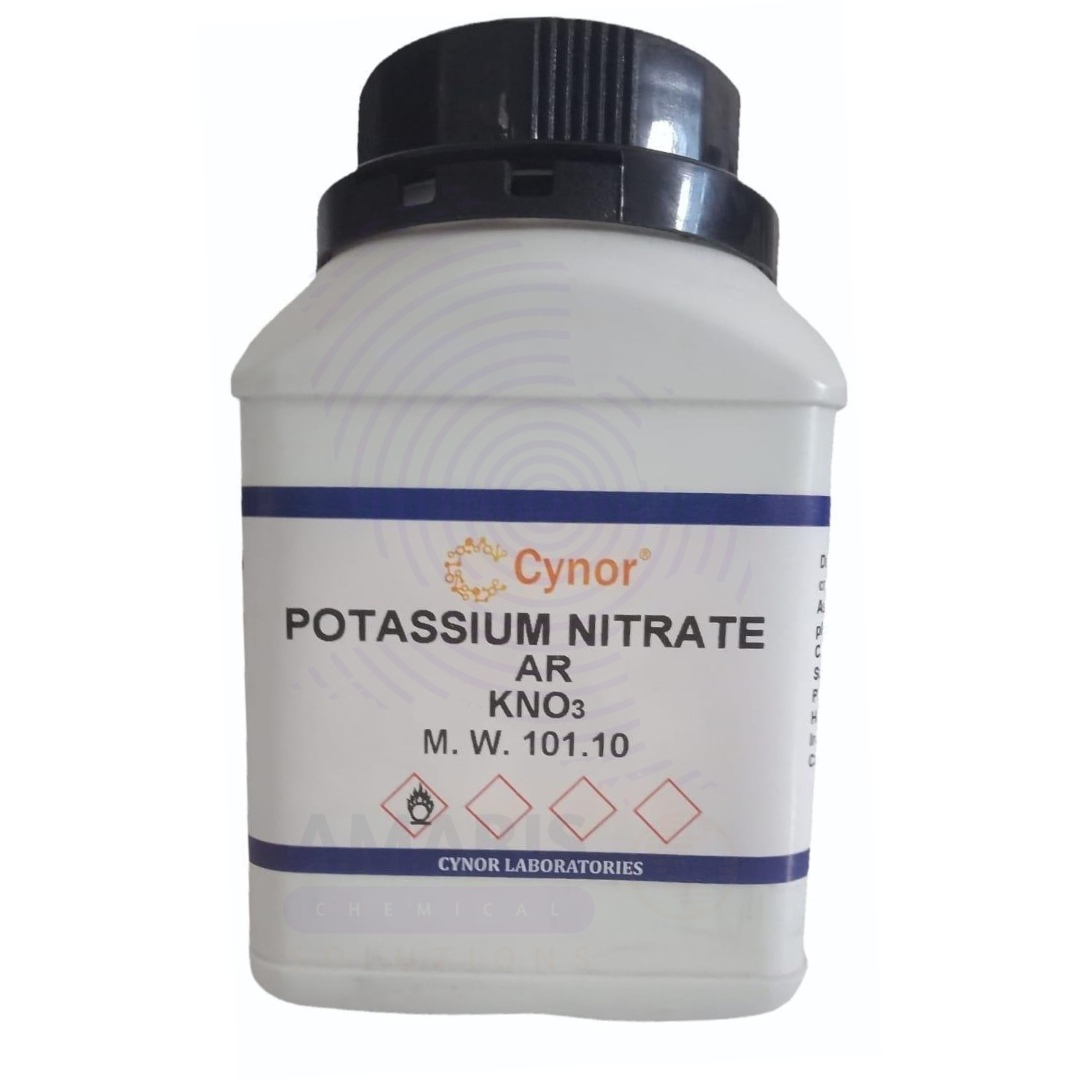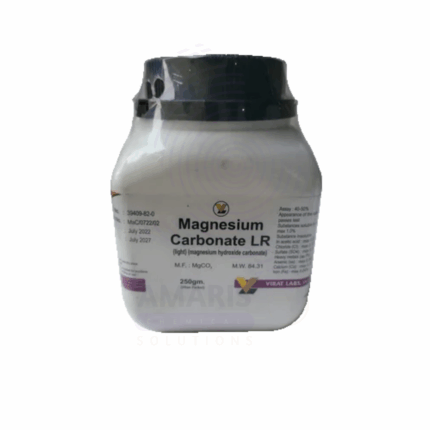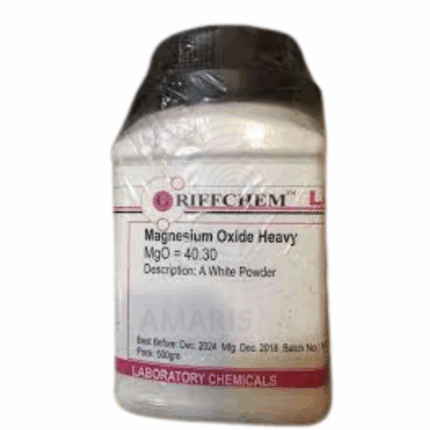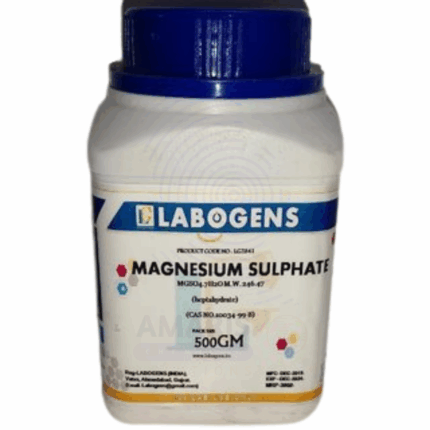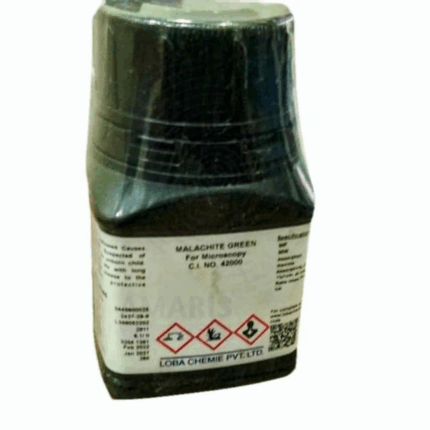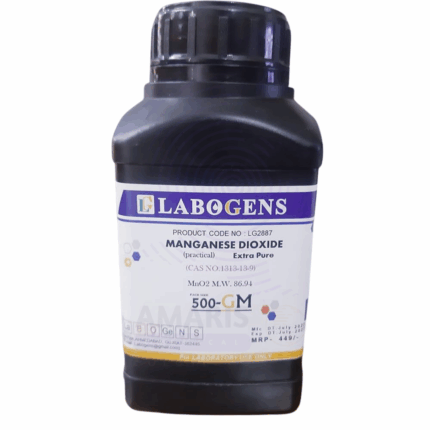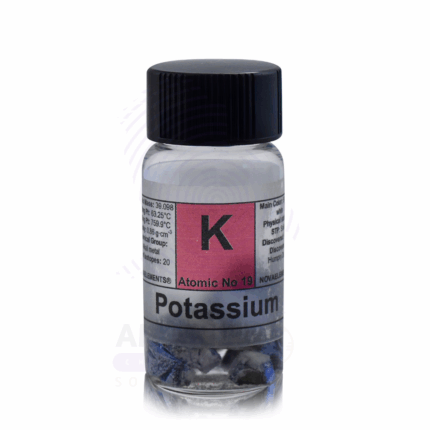
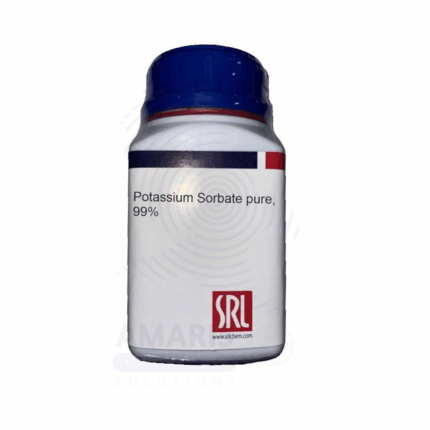
Potassium Nitrate Extra Pure
$ 17.69 Original price was: $ 17.69.$ 17.54Current price is: $ 17.54.
Potassium Nitrate Extra Pure is a high-purity, crystalline chemical compound widely used in laboratories, pharmaceuticals, and food-grade applications. It serves as a strong oxidizing agent, commonly employed in analytical chemistry, fertilizer formulation, and pyrotechnics. In pharmaceutical settings, it may be used in toothpaste for sensitive teeth, while in food processing, it can function as a preservative under strict regulatory control. Its extra pure grade ensures low levels of impurities, making it ideal for precision-dependent procedures. The compound should be stored in a cool, dry place away from incompatible substances to maintain its stability and reactivity.
Potassium Nitrate Extra Pure
PRIMARY USES
- Laboratory Reagent
- Widely used in analytical chemistry and educational experiments, especially in oxidation-reduction reactions.
- Acts as a source of nitrate ions in various chemical syntheses.
- Oxidizing Agent in Pyrotechnics
- A key ingredient in black powder (gunpowder), fireworks, and rocket propellants due to its strong oxidizing properties.
- Provides oxygen to support the combustion of other materials.
- Fertilizer (High Purity)
- Supplies essential nutrients: potassium (K) and nitrogen (N) for plant growth.
- Used in hydroponics and precision agriculture when extremely pure grade is needed.
SECONDARY USES
- Food Preservation
- Historically used to cure meats (known as saltpetre); however, modern use is regulated.
- Acts as an antimicrobial agent and helps retain meat color.
- Heat Transfer Media
- Used in solar thermal storage systems and heat transfer salt mixtures, especially in molten salt technology.
- Glass and Ceramic Manufacturing
- Improves strength and clarity of specialty glass and ceramics by acting as a fluxing agent.
1. Basic Identification Attributes
- Chemical Name: Potassium Nitrate
- CAS Number: 7757-79-1
- HS Code: 2834.21.00
- Molecular Formula: KNO₃
- Synonyms:
- Saltpeter
- Nitrate of Potash
- Nitric Acid, Potassium Salt
- E252 (as food additive)
2. Physical & Chemical Properties
- Physical State: Solid (granular or crystalline powder)
- Color & Odor: White or colorless; odorless
- Boiling Point & Melting Point:
- Melting Point: ~334 °C
- Decomposes before boiling
- Density/Specific Gravity: ~2.11 g/cm³ at 20 °C
- Solubility:
- Water: Highly soluble (32g/100 mL at 20 °C)
- Slightly soluble in glycerol
- Practically insoluble in ethanol and acetone
- pH Level: 6–8 (5% aqueous solution)
- Vapor Pressure & Volatility: Not volatile; negligible vapor pressure
- Flash Point: Not flammable
- Autoignition Temperature: Not applicable
- Viscosity: Not applicable (solid)
3. Safety & Hazard Attributes
- Hazard Class (GHS Classification):
- Oxidizing Solid (Category 3)
- Eye Irritation (Category 2A)
- NFPA Ratings:
- Health: 1
- Flammability: 0
- Reactivity: 1
- Exposure Limits:
- No specific OSHA PEL
- ACGIH TLV: Not established
- Reactivity:
- Strong oxidizer
- Reacts violently with reducing agents, flammable and combustible materials, and acids
4. Storage & Handling Attributes
- Storage Conditions:
- Store in a tightly closed container
- Cool, dry, and well-ventilated area
- Protect from heat, moisture, and combustible substances
- Incompatible Materials:
- Reducing agents, sulfur, powdered metals, organic materials, acids
- Container Type:
- Use plastic, HDPE, or coated metal containers resistant to corrosion and oxidation
- Shelf Life & Expiration Date:
- Long shelf life if stored dry and sealed (2–3 years or longer)
- Special Handling Requirements:
- Use gloves, goggles, lab coat
- Avoid creating dust; do not mix with combustibles
5. Regulatory & Compliance Attributes
- Regulatory Status:
- Listed under REACH, TSCA, FDA (as food additive E252)
- EPA: Recognized for nitrate pollution concerns
- Transportation Restrictions:
- UN Number: UN1486
- DOT Hazard Class: 5.1 (Oxidizer)
- Packing Group: III
- Waste Disposal Method:
- Dispose of via licensed hazardous waste disposal contractor
- Avoid release into environment or sewage
6. Environmental & Health Impact
- Ecotoxicity:
- Toxic to aquatic life in high concentrations
- Contributes to algal blooms and eutrophication
- Persistence in Environment:
- Persistent as nitrate ions; leaches into groundwater
- Carcinogenicity/Mutagenicity:
- Not listed as carcinogenic by IARC, NTP, or OSHA
- Biodegradability:
- Not biodegradable; mobile in soil and water systems
- Not biodegradable; mobile in soil and water systems
SAFETY PRECAUTIONS
Personal Protective Equipment (PPE):
- Chemical-resistant lab coat
- Nitrile or neoprene gloves
- Safety goggles or face shield
- Use in a well-ventilated fume hood or with local exhaust ventilation
Handling:
- Handle with care; avoid creating dust
- Do not mix with combustible materials, acids, or reducing agents
- Avoid contact with skin, eyes, and clothing
- Prevent contamination with organic substances (may cause violent reactions)
Storage:
- Store in a tightly sealed container in a cool, dry, well-ventilated area
- Keep away from heat, sparks, and sources of ignition
- Do not store near flammable or combustible materials
- Separate from acids, metal powders, and reducing agents
FIRST AID MEASURES
Inhalation:
- Move person to fresh air
- Loosen tight clothing and ensure clear airway
- If symptoms persist, seek medical attention
Skin Contact:
- Wash affected area with plenty of soap and water
- Remove contaminated clothing
- Seek medical attention if irritation develops
Eye Contact:
- Rinse cautiously with water for at least 15 minutes
- Remove contact lenses if present and easy to do
- Seek medical advice if irritation or discomfort continues
Ingestion:
- Rinse mouth with water
- Do NOT induce vomiting
- Seek immediate medical assistance
FIRE FIGHTING MEASURES
Flammability:
- Not flammable, but a strong oxidizer
- May intensify fire in presence of combustible material
Extinguishing Media:
- Use water spray, fog, or foam
- Do NOT use dry chemical extinguishers on large fires involving nitrates
Hazardous Combustion Products:
- Toxic gases including nitrogen oxides (NOₓ) and potassium oxides
Firefighter Protection:
- Wear full protective gear and a self-contained breathing apparatus (SCBA)
- Approach fire from upwind side
- Use water to cool containers exposed to fire


 Preservatives(food)
Preservatives(food) Flavor Enhancers
Flavor Enhancers Acidulants
Acidulants Sweeteners
Sweeteners Antioxidants
Antioxidants Colorants(food)
Colorants(food) Nutraceutical Ingredients (food)
Nutraceutical Ingredients (food) Nutrient Supplements
Nutrient Supplements Emulsifiers
Emulsifiers
 Collectors
Collectors Dust Suppressants
Dust Suppressants Explosives and Blasting Agents
Explosives and Blasting Agents Flocculants and Coagulants
Flocculants and Coagulants Frothers
Frothers Leaching Agents
Leaching Agents pH Modifiers
pH Modifiers Precious Metal Extraction Agents
Precious Metal Extraction Agents
 Antioxidants(plastic)
Antioxidants(plastic) Colorants (Pigments, Dyes)
Colorants (Pigments, Dyes) Fillers and Reinforcements
Fillers and Reinforcements Flame Retardants
Flame Retardants Monomers
Monomers Plasticizers
Plasticizers Polymerization Initiators
Polymerization Initiators Stabilizers (UV, Heat)
Stabilizers (UV, Heat)
 Antifoaming Agents
Antifoaming Agents Chelating Agents
Chelating Agents Coagulants and Flocculants
Coagulants and Flocculants Corrosion Inhibitors
Corrosion Inhibitors Disinfectants and Biocides
Disinfectants and Biocides Oxidizing Agents
Oxidizing Agents pH Adjusters
pH Adjusters Scale Inhibitors( water)
Scale Inhibitors( water)
 Antioxidants(cosmetic)
Antioxidants(cosmetic) Emollients
Emollients Fragrances and Essential Oils
Fragrances and Essential Oils Humectants
Humectants Preservatives
Preservatives Surfactants(cosmetic)
Surfactants(cosmetic) Thickeners
Thickeners UV Filters
UV Filters
 Fertilizers
Fertilizers Soil Conditioners
Soil Conditioners Plant Growth Regulators
Plant Growth Regulators Animal Feed Additives
Animal Feed Additives Biostimulants
Biostimulants Pesticides (Herbicides, Insecticides, Fungicides)
Pesticides (Herbicides, Insecticides, Fungicides)
 Active Pharmaceutical Ingredients (APIs)
Active Pharmaceutical Ingredients (APIs) Excipients
Excipients Solvents(pharmaceutical)
Solvents(pharmaceutical) Antibiotics
Antibiotics Antiseptics and Disinfectants
Antiseptics and Disinfectants Vaccine Adjuvants
Vaccine Adjuvants Nutraceutical Ingredients (pharmaceutical)
Nutraceutical Ingredients (pharmaceutical) Analgesics & Antipyretics
Analgesics & Antipyretics
 Analytical Reagents
Analytical Reagents Solvents(lab)
Solvents(lab) Chromatography Chemicals
Chromatography Chemicals Spectroscopy Reagents
Spectroscopy Reagents microbiology-and-cell-culture-reagents
microbiology-and-cell-culture-reagents Molecular Biology Reagents
Molecular Biology Reagents Biochemical Reagents
Biochemical Reagents Inorganic and Organic Standards
Inorganic and Organic Standards Laboratory Safety Chemicals
Laboratory Safety Chemicals Specialty Laboratory Chemicals(Special Laboratory Equipment)
Specialty Laboratory Chemicals(Special Laboratory Equipment)
 Demulsifiers
Demulsifiers Hydraulic Fracturing Fluids
Hydraulic Fracturing Fluids Scale Inhibitors(oil)
Scale Inhibitors(oil) Surfactants(oil)
Surfactants(oil) Drilling Fluids
Drilling Fluids
 Dyes and Pigments
Dyes and Pigments Bleaching Agents
Bleaching Agents Softening Agents
Softening Agents Finishing Agents
Finishing Agents Antistatic Agents
Antistatic Agents
 Admixtures
Admixtures Waterproofing Agents
Waterproofing Agents Sealants and Adhesives
Sealants and Adhesives Curing Compounds
Curing Compounds Concrete Repair Chemicals
Concrete Repair Chemicals Anti-Corrosion Coatings
Anti-Corrosion Coatings
 Surfactants(cleaning)
Surfactants(cleaning) Builders
Builders Enzymes
Enzymes Solvents (Cleaning)
Solvents (Cleaning) Fragrances
Fragrances
 Electronic Chemicals
Electronic Chemicals Catalysts
Catalysts Lubricants
Lubricants Photographic Chemicals
Photographic Chemicals Refrigerants
Refrigerants Automotive chemicals
Automotive chemicals Pyrotechnic Chemicals
Pyrotechnic Chemicals
 Biodegradable Surfactants
Biodegradable Surfactants Bio-based Solvents
Bio-based Solvents Renewable Polymers
Renewable Polymers Carbon Capture Chemicals
Carbon Capture Chemicals Wastewater Treatment Chemicals
Wastewater Treatment Chemicals
 Pigments
Pigments Solvents(paint)
Solvents(paint) Specialty Coatings
Specialty Coatings Binders/Resins
Binders/Resins Additives
Additives Driers
Driers Anti-Corrosion Agents
Anti-Corrosion Agents Functional Coatings
Functional Coatings Application-Specific Coatings
Application-Specific Coatings
 Fresh Herbs
Fresh Herbs Ground Spices
Ground Spices Whole Spices
Whole Spices Spice Blends
Spice Blends Dried Herbs
Dried Herbs
 Leavening Agents
Leavening Agents Dough Conditioners
Dough Conditioners Flour Treatments
Flour Treatments Fat Replacers
Fat Replacers Decoratives
Decoratives Preservatives(baking)
Preservatives(baking)
 Plasticizers & Softeners
Plasticizers & Softeners Reinforcing Agents
Reinforcing Agents Adhesion Promoters
Adhesion Promoters Vulcanizing Agents
Vulcanizing Agents Antidegradants
Antidegradants Blowing Agents
Blowing Agents Fillers & Extenders
Fillers & Extenders Accelerators & Retarders
Accelerators & Retarders